Navigating Wet Environments: The Critical Role of High-Performance Ankle Fishing Boots in Industrial and Recreational Settings
In demanding environments where moisture, challenging terrain, and the need for agile movement converge, the choice of footwear is paramount. This article delves into the technical specifications, manufacturing precision, and diverse applications of modern ankle fishing boots. Designed for professionals and enthusiasts alike, these boots offer a crucial blend of protection, comfort, and durability, making them indispensable across various B2B sectors, from commercial fishing and aquaculture to industrial maintenance and water supply infrastructure.
We will explore the underlying engineering principles, material science, and quality assurance protocols that define leading products like the Mid Rubber Deck Boots SY969-6. Understanding these aspects is vital for procurement specialists and engineers seeking optimal solutions for their operational needs.
Industry Trends and Market Dynamics for Ankle-High Footwear
The market for specialized outdoor and industrial footwear, including ankle fishing boots and related categories such as ankle high fishing boots, has seen significant evolution. Key trends include an increased demand for enhanced safety features, superior ergonomic design for prolonged wear, and environmentally sustainable manufacturing practices.
- Advanced Materials: A shift towards lightweight, durable, and chemical-resistant compounds, often incorporating recycled content. For instance, new rubber formulations offer better abrasion resistance and flexibility in cold temperatures without compromising grip.
- Ergonomic Design: Focus on anatomical fit, arch support, and shock absorption to reduce fatigue during long shifts, crucial for roles requiring extensive standing or movement on uneven surfaces.
- Multi-Purpose Functionality: Products like ankle hunting boots and hunter mid calf boots are converging in features with industrial models, offering versatility for cross-sector applications that require waterproofing and robust traction. The demand for boots suitable for both fishing and general outdoor activities that need reliable waterproofing is growing.
- Enhanced Safety Standards: Adherence to global safety certifications (e.g., ASTM F2413, ISO 20345) for features like slip resistance, electrical hazard protection, and puncture resistance is becoming standard.
These trends reflect an industry-wide commitment to worker safety, productivity, and environmental responsibility, driving innovation in footwear design and manufacturing.
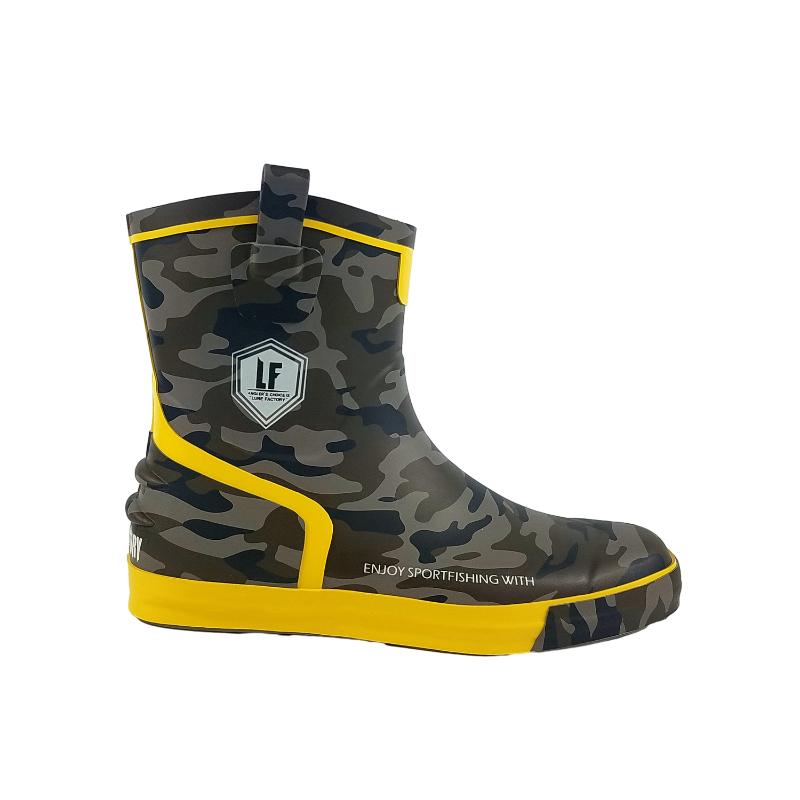
Manufacturing Process Flow for High-Performance Ankle Boots
The production of durable ankle fishing boots involves a multi-stage, precision-controlled process, combining advanced material science with stringent quality assurance. Our Mid Rubber Deck Boots SY969-6 exemplifies this commitment to excellence.
Key Stages:
1. Material Selection & Preparation: High-grade natural rubber and synthetic polymers (e.g., styrene-butadiene rubber, neoprene) are carefully selected for optimal flexibility, waterproofing, and resistance to saltwater and common chemicals. Rubber compounds are mixed with vulcanizing agents, accelerators, and pigments, then calendered into sheets or extruded into profiles.
2. Component Cutting & Assembly: Specialized cutting machines (often CNC-controlled for precision) cut various patterns for the upper, lining, and reinforcements. These pieces are then hand-assembled or robotically positioned over a last (a foot-shaped mold) to form the boot's shape. This stage ensures the anatomical correctness and fit.
3. Sole Molding & Attachment: The outsole, often featuring advanced anti-slip patterns, is typically compression molded or injection molded from a high-traction rubber compound. This sole is then securely bonded to the boot upper, often through direct vulcanization, creating an impenetrable waterproof seal. Techniques such as vulcanization ensure a molecular bond, vastly superior to mere adhesive bonding for longevity and integrity.
4. Vulcanization (Curing): This critical process transforms the raw rubber into a highly durable, elastic, and chemical-resistant material. Boots are placed in vulcanization ovens where heat and pressure cross-link the polymer chains, dramatically improving mechanical properties, service life, and chemical resistance. This is essential for boots used in industries like petrochemicals and metallurgy.
5. Finishing & Quality Control: After vulcanization, boots undergo trimming, cleaning, and a rigorous series of tests. These include hydrostatic pressure testing for waterproofing, abrasion resistance tests (e.g., ISO 20344), slip resistance measurements (e.g., SATRA TM144/EN ISO 13287 for SRC rating), and visual inspections for any manufacturing defects. Batch testing ensures consistent quality and adherence to specifications.
Our processes adhere to international standards such as ISO 9001 for quality management and ISO 20345 for personal protective equipment, ensuring a service life typically exceeding 3-5 years under normal industrial conditions, with optimal corrosion resistance for specific chemical exposures.
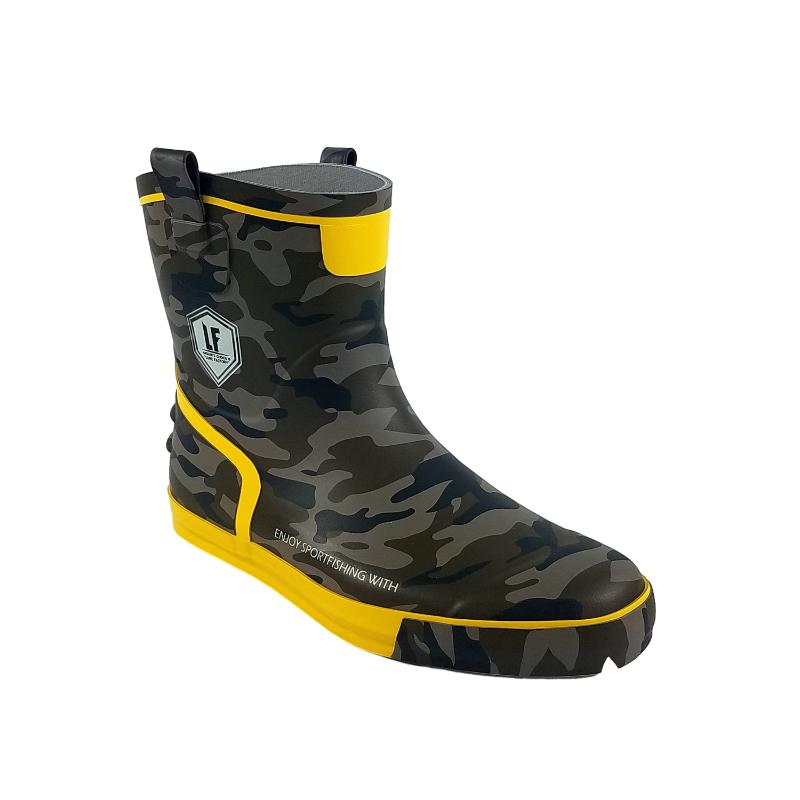
Technical Specifications: Mid Rubber Deck Boots SY969-6
The Mid Rubber Deck Boots SY969-6 are engineered to provide superior performance in wet, slippery, and challenging environments. These specifications highlight its robust design and suitability for professional applications.
These robust specifications underpin the reliability and performance expected by professionals in demanding fields.

Application Scenarios and Target Industries
The versatile design and protective features of high-quality rubber boots extend their utility across a broad spectrum of industries and operational contexts. From preventing slips on offshore rigs to ensuring comfort during urban flood control, the applications are extensive.
- Commercial Fishing & Aquaculture: Indispensable for deckhands and aquaculture workers, offering superior grip on wet, fish-slimed decks and protection from saltwater and ice. Essential for maintaining hygiene and preventing bacterial ingress.
- Marine & Offshore Operations: Workers on oil rigs, research vessels, and marine construction sites rely on them for anti-slip properties and chemical resistance against fuels and lubricants.
- Water Supply & Drainage Utilities: Maintenance crews operating in sewers, pumping stations, and flood-prone areas require reliable waterproofing and robust construction. The boots facilitate safe navigation through standing water and sludge.
- Petrochemical Industry: Certain formulations offer enhanced resistance to hydrocarbons and corrosive agents, making them suitable for plant inspections and maintenance in potentially hazardous environments.
- Agriculture & Farming: For tasks involving muddy fields, handling chemicals, or cleaning livestock pens, these boots provide essential protection and ease of cleaning.
- General Outdoor & Recreational Use: Enthusiasts requiring robust footwear for wading, casual fishing, or even as hunt pac mid boot alternatives appreciate the comfort and waterproof capabilities.
In scenarios where both flexibility and formidable protection are needed, the Mid Rubber Deck Boots SY969-6 stands as a prime example of effective engineering.
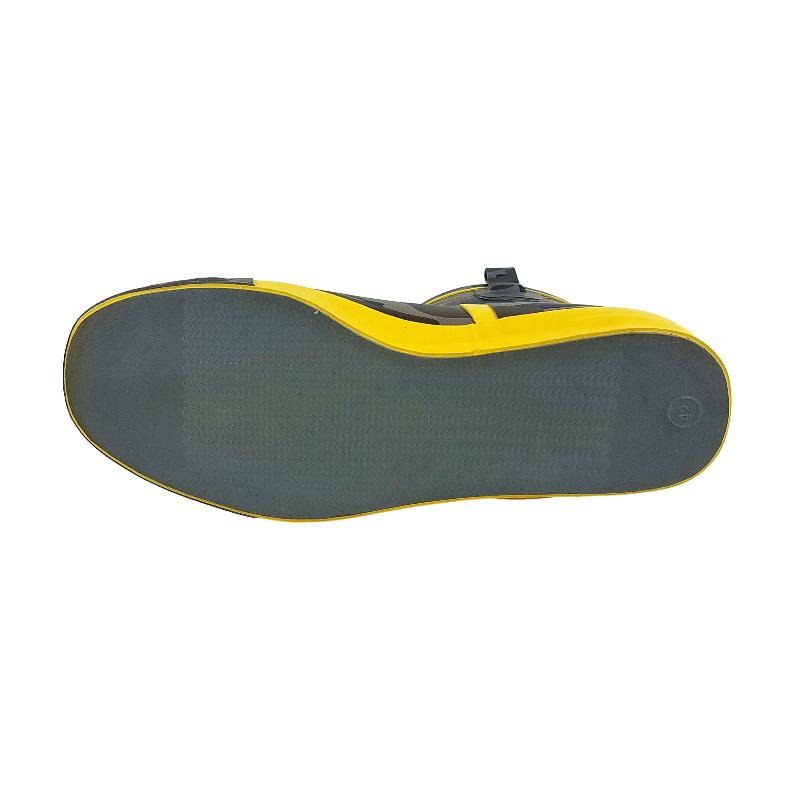
Technical Advantages and Performance Metrics
The technical advantages of modern ankle fishing boots stem from continuous innovation in material science and design. Performance metrics are rigorously tested to ensure reliability in challenging conditions.
- Superior Slip Resistance (SRC Rated): Our boots consistently achieve SRC ratings under EN ISO 13287, signifying excellent grip on both ceramic tile with soap solution and steel with glycerol. This drastically reduces the risk of falls on wet or oily surfaces, leading to improved worker safety and reduced lost time injuries.
- Enhanced Corrosion and Chemical Resistance: Specially formulated rubber compounds resist degradation from acids, alkalis, and petroleum products common in industrial settings. This extends the boot's service life and protects the wearer from chemical burns, an advantage in petrochemical and water treatment sectors.
- Optimal Thermal Regulation: The layered construction, including quick-dry linings, provides insulation for varied temperatures. This contributes to wearer comfort and foot health by preventing excessive sweating or chilling.
- Ergonomic Fit for Reduced Fatigue: Anatomically designed lasts and cushioned insoles provide arch support and shock absorption, distributing pressure evenly. This significantly reduces foot and leg fatigue over extended periods of wear, a direct benefit for productivity.
- Puncture and Abrasion Resistance: The robust rubber shell is inherently resistant to punctures from sharp objects and abrasions from rough surfaces, providing a durable barrier against hazards. This prolongs the life of the boot and protects the wearer in environments like construction sites or rocky terrains.
These combined advantages result in a lower total cost of ownership through extended product life, reduced safety incidents, and improved workforce morale.
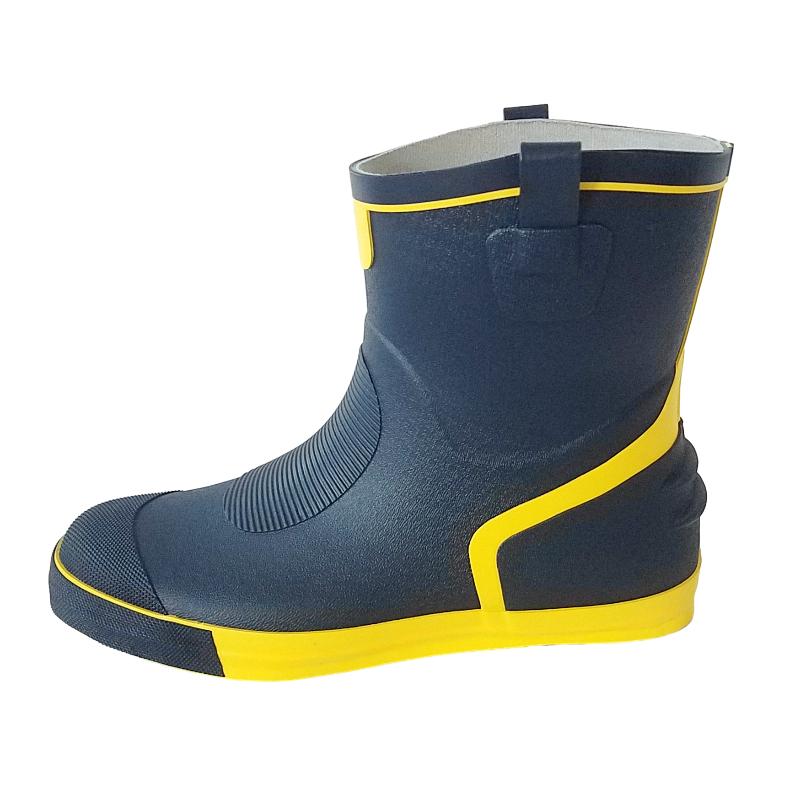
Vendor Comparison: Evaluating Performance and Value
When selecting industrial footwear, a comprehensive vendor comparison is crucial. While many manufacturers offer boots, differentiators lie in material quality, construction techniques, adherence to standards, and after-sales support. Below is a comparison table showcasing how our Mid Rubber Deck Boots SY969-6 stacks up against typical market offerings.
Our Mid Rubber Deck Boots SY969-6 offers a compelling balance of high-performance features, certified safety, and durability at a competitive price point, making it a strategic choice for businesses focused on long-term value and operational efficiency.
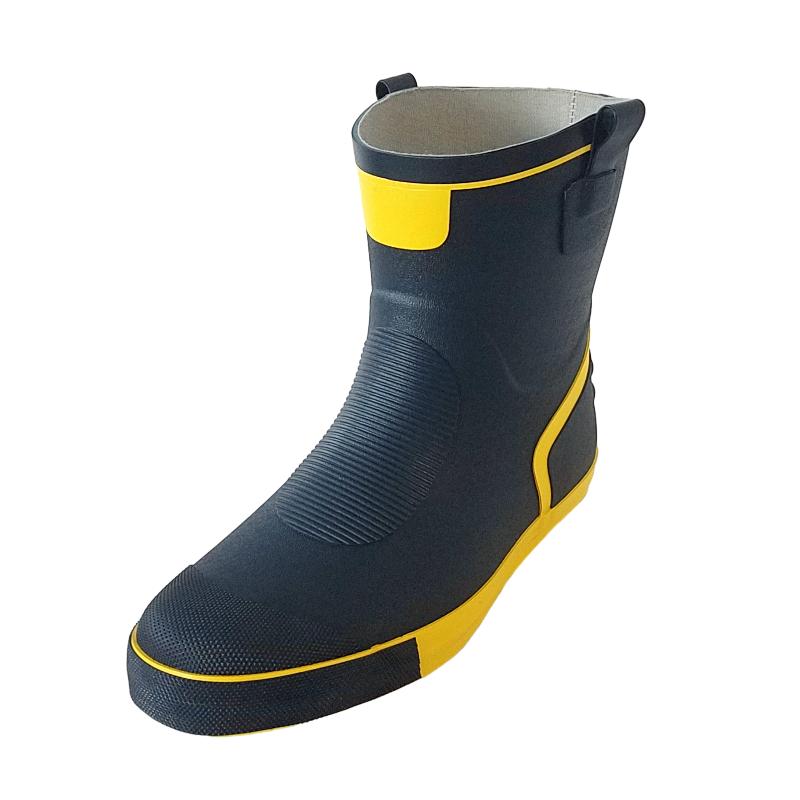
Customized Solutions for Specific Industrial Needs
Recognizing that standard solutions may not always meet every unique operational requirement, we offer tailored customization options for our ankle fishing boots and other industrial footwear.
- Material Modifications: For extreme chemical exposures (e.g., highly concentrated acids or specific solvents), we can integrate specialized polymer blends (e.g., nitrile rubber, EPDM) to enhance chemical resistance beyond standard formulations.
- Enhanced Safety Features: Options include integrated steel or composite toe caps (meeting ASTM F2413 or EN ISO 20345 S3 standards), puncture-resistant midsoles, and electrical hazard (EH) resistant soles for specific work environments.
- Thermal Insulation Upgrades: For operations in sub-zero temperatures, boots can be fitted with additional insulating layers (e.g., neoprene, Thinsulate™ equivalents) to maintain thermal comfort.
- Branding and Color: Custom color schemes and corporate branding (logos, team names) can be integrated for large-volume orders, enhancing brand identity and distinguishing different operational teams.
- Ergonomic Adaptations: For organizations addressing specific ergonomic challenges, we can explore custom last designs or specialized orthotic-compatible insoles.
Our R&D team works closely with clients to understand their unique environmental factors and regulatory requirements, ensuring that customized solutions deliver optimal performance and compliance.
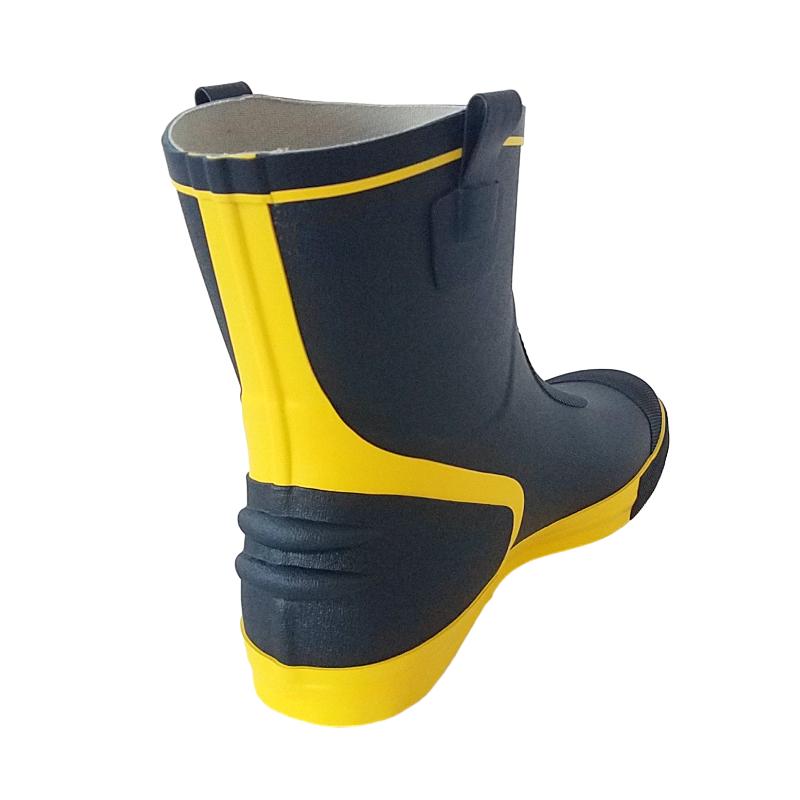
Application Case Studies: Proven Performance in the Field
Our extensive experience (over 20 years in specialized footwear manufacturing) and strong partnerships with leading industrial clients attest to the reliability and performance of our products. Here are illustrative case studies:
Case Study 1: Commercial Fishing Fleet, North Atlantic
A major commercial fishing company operating in the challenging North Atlantic deployed Mid Rubber Deck Boots SY969-6 across its fleet. Prior to this, they experienced high rates of boot replacement (every 9-12 months) due to sole delamination and rapid wear from constant exposure to saltwater, fish oils, and ice. After transitioning to our vulcanized boots, the average service life increased to 2.5 years, representing a significant reduction in procurement costs and unscheduled downtime for equipment replacement. Crew feedback highlighted improved grip on wet decks, contributing to a 15% reduction in minor slip-related incidents during the first year of deployment, validating the SRC certification in real-world conditions.
Case Study 2: Municipal Water Treatment Plant, Coastal Region
A municipal water treatment facility near a coastal area required robust footwear for technicians who regularly worked in environments with standing water, mild chemical solutions (chlorine, flocculants), and slippery concrete surfaces. Their previous footwear suffered from poor chemical resistance and inadequate slip protection. Implementing our boots provided a 100% waterproof barrier, enhanced chemical resistance, and, critically, superior SRC-rated traction. This led to zero reported foot-related injuries over an 18-month period, a substantial improvement in worker safety and compliance with OSHA guidelines.
These cases demonstrate tangible benefits in safety, durability, and operational efficiency, reinforcing the value proposition of our technically advanced ankle fishing boots.
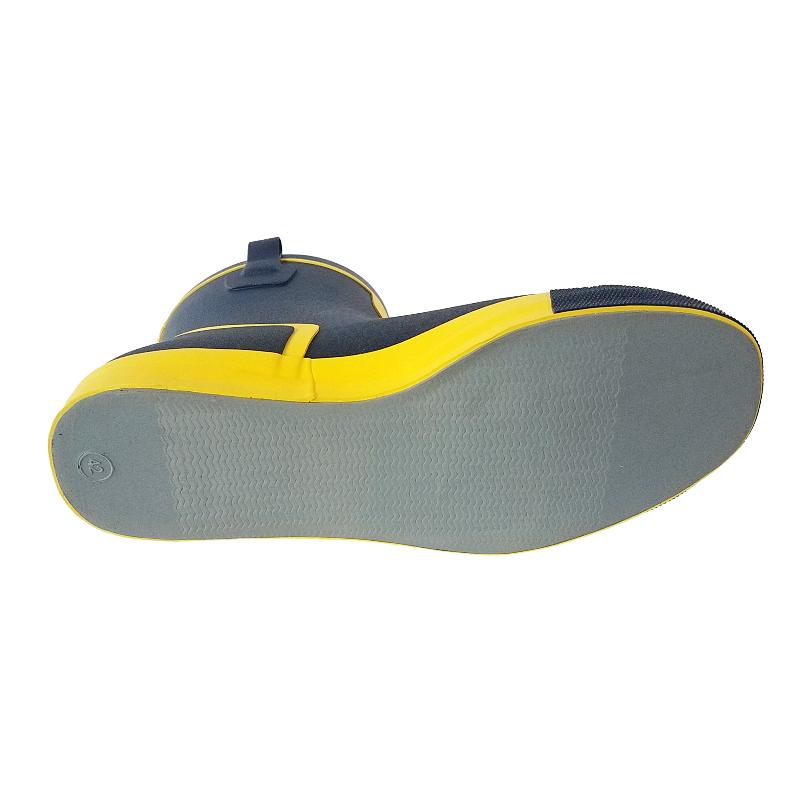
Frequently Asked Questions (FAQ)
Q1: What makes these boots suitable for both fishing and industrial applications?
A1: The Mid Rubber Deck Boots SY969-6 combines 100% vulcanized waterproofing, SRC-rated slip resistance, and high-grade rubber construction. These properties are universally beneficial in wet, slippery, and potentially chemical-exposed environments, whether on a fishing boat or an industrial deck. The ankle high fishing boots design also offers agility without compromising protection.
Q2: Are these boots resistant to common industrial chemicals?
A2: Yes, the boots are formulated with natural rubber and SBR compounds that provide good resistance to common marine oils, diesel fuel, and mild acids/alkalis. For specific, aggressive chemical exposures, we recommend exploring our customized solutions with specialized material compositions.
Q3: What is the expected service life of these boots in a typical industrial setting?
A3: Under normal industrial use and proper maintenance, the Mid Rubber Deck Boots SY969-6 has an expected service life of 3-5 years. Factors such as exposure to extreme temperatures, harsh chemicals, and mechanical abrasion can influence actual longevity.
Q4: Do you offer safety toe versions?
A4: Yes, while the standard SY969-6 is a non-safety toe boot (OB rating), we offer versions with integrated steel or composite toe caps that meet international safety standards like ASTM F2413 or EN ISO 20345 (S3), available through our customized solutions program. These are ideal for environments requiring impact and compression protection.
Lead Time, Warranty, and Customer Support
We understand the critical importance of reliable supply chains and robust after-sales support for our B2B clients.
- Lead Time & Fulfillment: Standard orders for our Mid Rubber Deck Boots SY969-6 typically have a lead time of 4-6 weeks, depending on order volume and current production schedule. Expedited options are available for urgent requirements, and we maintain strategic stock levels for common sizes to facilitate quicker dispatch. Our robust logistics network ensures efficient global delivery.
- Warranty Commitments: All our products, including the ankle fishing boots, come with a 12-month limited warranty against manufacturing defects and material failures under normal use. This warranty underscores our confidence in the quality and durability of our craftsmanship and materials. Detailed warranty terms are available upon request.
- Customer Support: Our dedicated B2B customer support team is available from Monday to Friday, 9:00 AM to 5:00 PM (GMT+8). We provide comprehensive technical assistance, order tracking, and after-sales service. For inquiries or support, please contact us via email at sales@landwalk-outdoor.com or call +86-571-88888888. Our commitment is to ensure seamless client experiences and long-term satisfaction.

Conclusion
The selection of appropriate footwear for demanding industrial and outdoor environments is a strategic decision impacting safety, productivity, and operational costs. High-performance boots, exemplified by the Mid Rubber Deck Boots SY969-6, offer a compelling solution through their advanced materials, precise manufacturing, and rigorous adherence to international safety standards. By understanding the detailed technical specifications, application scenarios, and robust support infrastructure, B2B decision-makers can confidently invest in footwear that delivers sustained value and protection.
References
- International Organization for Standardization (ISO). ISO 20345:2021: Personal protective equipment – Safety footwear.
- ASTM International. ASTM F2413: Standard Specification for Performance Requirements for Protective (Safety) Toe Cap Footwear.
- Health and Safety Executive (HSE) UK. Guidance on slip resistance of footwear.
- Rubber Manufacturers Association (RMA). Rubber Handbook: Properties of Elastomers.
- Occupational Safety and Health Administration (OSHA). Personal Protective Equipment (PPE) standards.
-
Floral Rain Boots with Soft Inner LiningNewsAug.22,2025
-
Farm Boots Rubber with Mud Resistant SolesNewsAug.22,2025
-
Insulated Wellies for High Voltage WorkNewsAug.22,2025
-
Fire Rescue Boots with Ankle SupportNewsAug.22,2025
-
Thermal Safety Wellies Honoring Workplace CareNewsAug.22,2025
-
Waterproof Wellies Our Promise of All-Season PerformanceNewsAug.22,2025
-
Stay Dry in Any Condition with WadersNewsJul.17,2025











